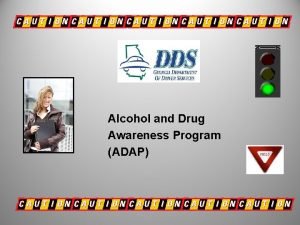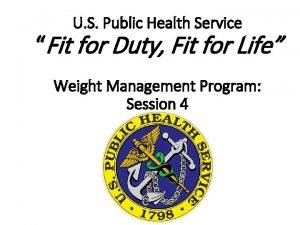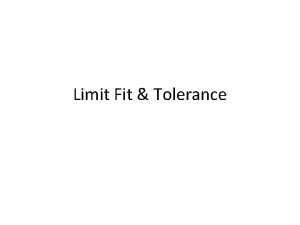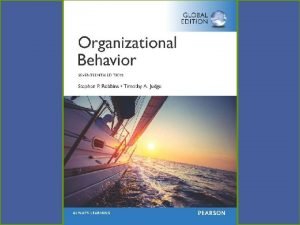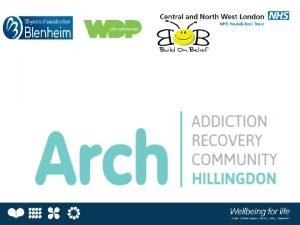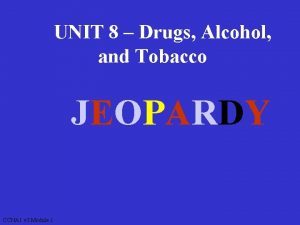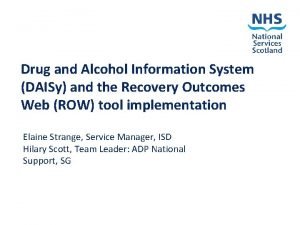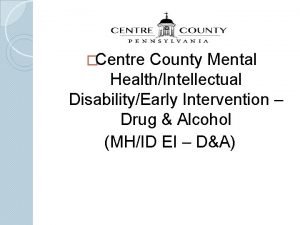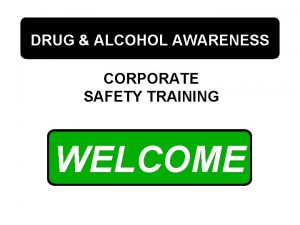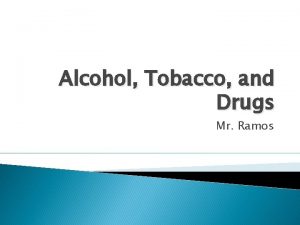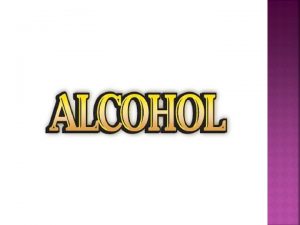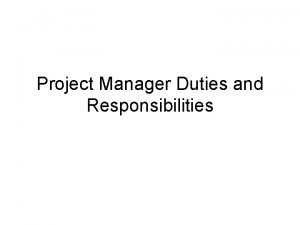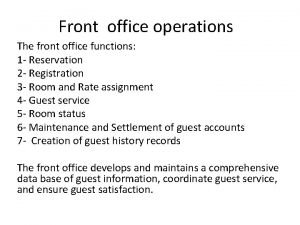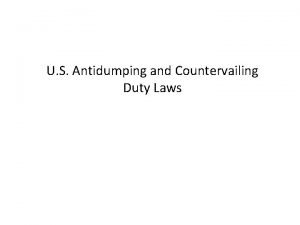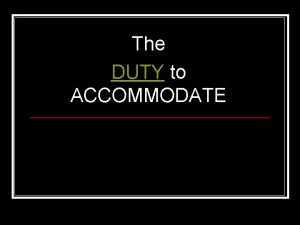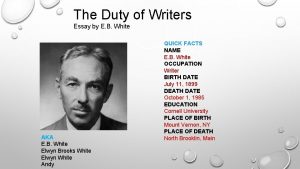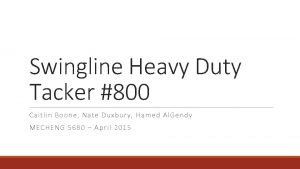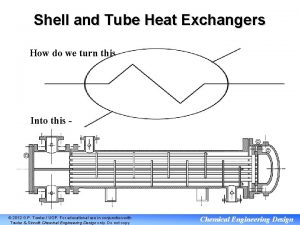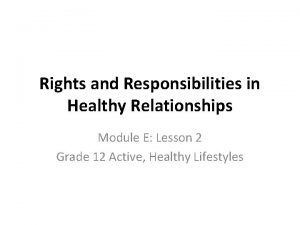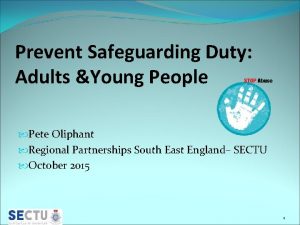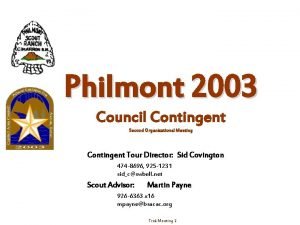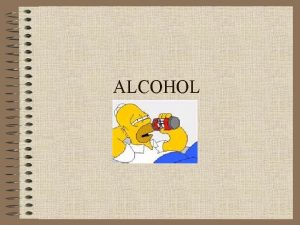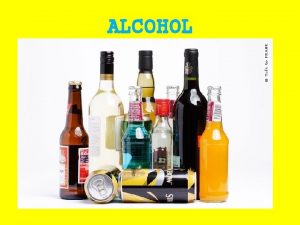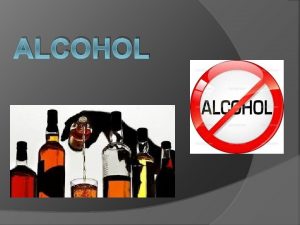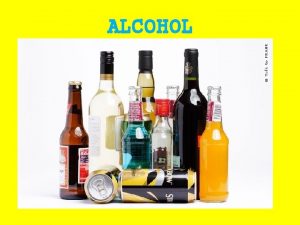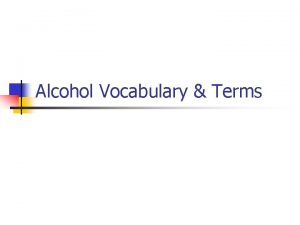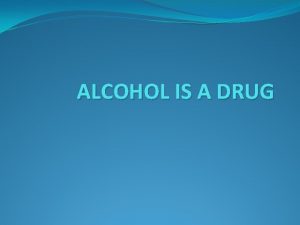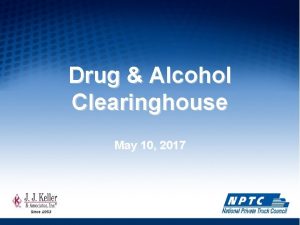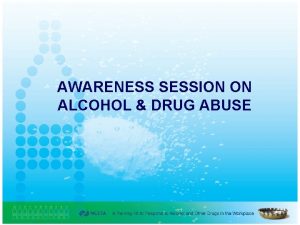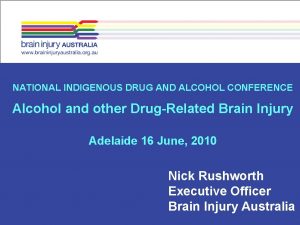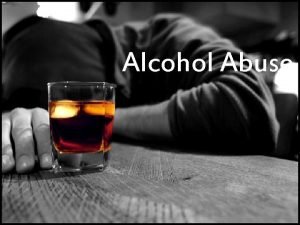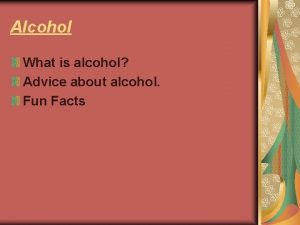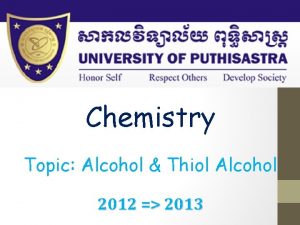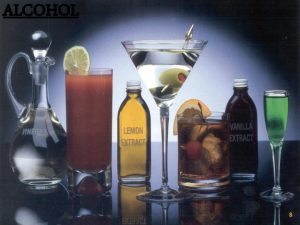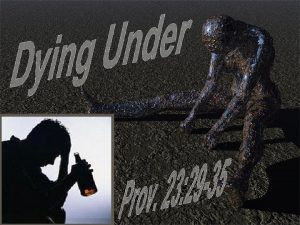ALCOHOL AND DRUG AWARENESS AND FIT FOR DUTY






































































































- Slides: 102

ALCOHOL AND DRUG AWARENESS AND “FIT FOR DUTY” TRAINING FOR SUPERVISORS DCM-CR-FR-324 -A Rev 1. 0 1

What we will discuss Identification of various types of drugs, the ways of use, paraphernalia, and how it affects the user 2

Three Types of Substance Abuse Illegal or Illicit Drugs Prescription & Over the Counter Drugs Alcohol 3

Substance Abuse Cause Problems with: n Thinking ability n Memory n Movement and coordination n Ability to drive, operate machines and equipment 4

Statistics n Typically workers: Canadian workplace of 1000 – 200 are non-drinkers – 544 are responsible drinkers – 224 exceed responsible guidelines – 32 have alcoholic levels of consumption n These are much higher in the trades industry. 5

Alberta Statistics n It is estimated that a total of 16, 738 employees used drugs at work during the previous year. n It is estimated that 184, 118 Alberta workers consumed alcohol at work during the previous 12 months. (AADAC) 6

Costs to the Company n 1 in 4 industrial fatalities and 47% of industrial injuries can be linked to alcohol consumption or drug use. n Generate health care costs that are 3 times as high as their non drug-using coworkers. n 5 times more likely to file a worker compensation claim twice the cost. 7

Cannabis 8

Marijuana n Marijuana is a green leaf-like material. n The ideal portion to smoke is the buds. n Marijuana is smoked in joints, (rolled like cigarettes) or in pipes. 9

Marijuana n One of the most widely used drugs. Possession of marijuana is a criminal offence in Canada. n The active ingredient is THC (tetrahydrocannabinol). n THC levels have gone from 3. 5% to 35% due to advanced cultivating techniques. n Fat soluble, lasting in the fat cells from 1 -30 days. 10

Hashish Hash is the resin removed from the marijuana plant. n. Hashish pipes. is usually smoked in Hash Oil – Weed Oil Contains high levels of THC, up to 50%. n Smoked by spreading it on a joint/cigarette. n 11

Some noticeable signs of marijuana abuse include: - Rapid, loud talking and bursts of laughter in early stages of intoxication. - Sleepy in the later stages. - Lack of concentration and coordination. - Forgetfulness in conversation. - Inflammation in whites of eyes. - Odor similar to burnt rope on clothing or breath. - Distorted sense of time passage - tendency to overestimate time intervals. - Craving for sweets. - Increased appetite. - Use or possession of paraphernalia including roach clip, packs of rolling papers, pipes or bongs. 12

The effects of marijuana will vary from person to person depending on: § Amount taken / Potency § Personal exposure § Method of ingestion (joint, bong, food) § Persons stature (size, weight, health) § Group atmosphere / Personal mood § Combined with other drugs 13

Short Term Effects of Marijuana Use n Memory and learning; n Distorted perception; n Difficulty in thinking and problem solving; n Loss of coordination; n And increased heart rate. 14

Long Term Effects n n n n Increase in the risk of getting bronchitis, lung cancer and other respiratory system diseases Decrease in motivation Decrease in concentration, memory and ability to learn new things Lowered sex drive Decreased sperm-count Irregular menstrual cycles Psychological effects may be experienced if the person already has a schizophrenic condition. 15

Cocaine 16

Cocaine n Cocaine hydrochloride is a water based substance. n Remains in the body between 12 -48 hours. n It can be snorted up the nose, it can be mixed with water and injected. 17

Cocaine n Cocaine is a potent central nervous system stimulant. n Leads to a psychological addiction. n Effects can last from 20 minutes to several hours depending on the dosage, purity and administration method. 18

Crack Cocaine n Cocaine that is mixed with water and sodium bicarbonate, cut into rocks, and smoked. n It is called "crack" because it snaps and cracks when heated and smoked. n Crack effects are felt almost immediately and last 5 – 15 minutes. n Cocaine users who turn to ‘crack’ often see their habit increases, and so does the expense. 19

Effects of Cocaine n Tolerance is developed and more cocaine is needed to achieve the same high. n Cocaine and crack take over from the normal pleasure neurotransmitter dopamine (controls movement, emotional response, ability to experience pleasure/pain). n The brain stops producing dopamine. n When the cocaine use subsides, there is no dopamine to create pleasure, user suffers depression and irritability. n The only way pleasure is obtained is through the use of cocaine. 20

Risks of Cocaine / Crack n Cardiac arrest is a risk to the first-time user. n Risk of heart attack is 7 x higher than of a non user. n During the first hour after cocaine / crack is used, heartattack rises 24 -fold. n Drinking alcohol while taking cocaine causes the liver to manufacture a third substance called coca ethylene – which intensifies the euphoric effects and increases the risk of sudden death. 21

Signs of Use n n n Sweating Hyperactivity Restlessness Constricted pupils Weight loss Euphoric behavior – Can be followed by feeling of discomfort and depression resulting in a craving for the drug. – Excessive dosage can produce itching, hallucinations, and paranoid delusions. 22

More Signs of Use n An unseen sign is elevated blood pressure - which can be life threatening. – – – – – Running nose, sniffing Bleeding nose Damaged septum Alienation from friends and family Crimes of violence Lying, cheating, stealing Loss of appetite Irritable, paranoid, confused Insomnia 23

Opiates 24

Opiate Derivatives n Many different drugs come from opiates: Percocet Demerol Vicodin Oxycontin Codeine Morphine Heroin Opium Tylenol 3 Tylenol 4 Dilaudid Methadone (synthetic opiate) 25

26

Heroin: Grades n Heroin typically is sold as a white or brownish powder or black sticky substance (Black Tar Heroin). Heroin may be cut with the following: n sugar, starch, powdered milk or quinine n Street heroin can also be cut with strychnine or other poisons. n n Street Names: Smack, junk 27

Heroin Preparation Heroin is not water soluble, so in order to inject it has to be cooked. 28

Heroin: Identifying the Use n n n Frequent, secret phone calls Depression Track marks Unexplained time away from home or work Sudden change in behavior Itching and scratching 29

Signs of Heroin Abuse n Vomiting n Constipation n Nodding Out n Increased activity level before nodding out n Use of laxatives (heroin causes constipation) n Loss of old, established friendships n New, undesirable friends n Weight loss 30

Signs of Heroin Abuse n Constricted, pinpoint pupils n Wearing sunglasses when not needed n Disappearance of spoons n Finding spoons with burn marks n Aluminum foil & gum wrappers with burn marks n Pawn shop receipts found n Theft of household valuables, tools, appliances, and jewelry n Missing shoelaces from shoes used as a tie off for injecting heroin n Bottles of vinegar and bleach (used to clean needles) n Cotton balls 31

General Risk Factors Intravenous Drug Use n Increased risk of HIV/Aids n Infected veins, abscesses or superficial skin ulcers n Fillers that weren’t dissolved can get into the lungs and cause breathing problems as well as lung disease. n There is high risk of infection in the heart, bones and liver. 32

Methamphetamine n Street names: speed, meth, crystal meth, chalk, Tic n Smokable forms: ice, crank, crystal, glass, tina n Effects in the central nervous system n Highly addictive 33

Crystal Meth n Main ingredients include: – Ephedrine, antifreeze, and lantern fuel n High may last up to 3 days n Remains in system for 5 days n Less than 10% success rate of recovery n Life span of chronic user is 5 -7 years 34

Effects of Meth n Signs of use: n Use may cause: n Acute lead poisoning, reduction of production of dopamine (pleasure regulator) n In attempt to intensify effects, user often change method of intake. – Weight loss, picking, open sores/lesions – – – Confusion Paranoia Anxiety Hypothermia Violent behavior – uncontrollable rages 35

Prescription Drugs & Over the Counter Drugs 36

Amphetamines n Initially used for treating nasal congestion and asthma (Benzedrine “Bennies”) n Used to treat obesity – Reduces appetite n Often abused by truck drivers or shift workers 37

Amphetamines n Amphetamines – “Speed” and Ecstasy are stimulants n Can cause a reduced sense of responsibility and decreased inhibition n White-yellow powder – – – Pill form Injected Inhaled through the nose 38

Amphetamines Immediate Effects After Effects § Wide awake § Hyperactivity § Weight loss § Anxiety/irritability § Very talkative § Dramatically increased energy & alertness § Increased blood pressure and pulse § Increased aggressiveness § Paranoia § Suspiciousness § Sleep for days after “coming down” § Reduced appetite § Seizures § Coma § Death 39

Barbiturates n A. K. A. - Downers n Long and short lasting – Long-acting drugs may last up to two days. – Others are very short acting lasting only a few minutes. n May be injected but usually taken as pills 40

Barbiturates n Effects similar to alcohol – makes one feel relaxed, sociable and goodhumored – slow breathing and lowering of blood pressure and heart rate – intoxicating – stumbling and staggering are common – high doses can cause serious side effects § § unpredictable emotional reactions mental confusion judgment becomes severely impaired mood swings 41

Mixing Alcohol with Barbiturates n Both have similar effects on the body – Reduces the amount of activity in the central nervous system Multiplies the effect of alcohol by 10 times n Mixing alcohol and barbiturates can be n FATAL! 42

Oxy. Contin: the New Street Drug of Choice for Many n a. k. a. Oxycotton or Oxy n Prescription painkiller n Opiate based drug n “Poor Man’s Heroin” Oxy. Contin Side effects: constipation, nausea, sedation, dizziness, vomiting, headache, dry mouth, sweating, and weakness and respiratory depression. 43

Ecstasy n n Synthetic psychoactive drug Usually white or yellow tablets Immediate effects: n Energizing effect, distorts time and perception and enhances enjoyment from tactile experiences – – – feelings of connection with other people increased confidence sweating anxiety/paranoid feelings increased blood pressure and heart rate n Other effects can include confusion, depression, sleep problems, drug craving, and severe anxiety. n Chronic users exhibit reduced serotonin transport in the brain. n These problems can occur during and sometimes days or weeks after taking it. 44

45

Date Rape Drugs n All of these drugs are similar to valium; however, they are many times stronger. n Inexpensive: $1 - $5 a hit n Causes blackouts n n n Allows the victim to be taken advantage of Theft Sexual assault 46

Date-Rape Drugs n Can be easily slipped in to a drink n Most are – Colorless – Odorless – Liquid or powder/pill form 47

Rohypnol is similar to Valium but about 10 times stronger. Veterinary drug to relax animals n Initially, Rohypnol causes: n n – – Muscle relaxation Dizziness and headaches Slows psychomotor responses Lowers inhibitions n Memory blackouts are typically 8 -12 hours long. n A less common use: the tablets are crushed, often mixed with other drugs, and snorted. – This route of administration is more common for recreational drug users than for rapists. 48

GHB – Gamma Hydroxy Butyrate n Clear liquid n Often disguised as water in a water bottle n Effects similar to impairment by alcohol 49

Other Effects of GHB n n n n n G-Hole – coma like state Visual disturbances Difficulty breathing Poisoning Tremors Seizures Sleep-walking Amnesia Coma Death n n n n Giddiness, silliness and dizziness Abrupt, intense drowsiness Decreased body temperature Decreased heart rate Vomiting Diarrhea Interference with mobility and verbal coherence 50

Hallucinogens 51

Hallucinogens n n A hallucination is a sensory experience of something that does not exist outside the mind. It affects your perception of time, reality, and surroundings. It may involve any or all of the 5 senses: – Hearing, seeing, smelling, tasting or feeling something that isn't really there. n Transposing of sensory modes or sensory crossover: n Hallucinations can be very frightening – I. e. seeing sounds as colors – Hearing an odor – – – User may be panic-stricken Person may be uncontrollable Known as "bad trips" 52

LSD : Lysergic Acid Diethylamide n Most powerful of all the hallucinogens n Psychedelic recreational drug – A. K. A. "acid" n Often added to absorbent paper – Each square represents one dose n Laboratory tests can be used to detect LSD in the blood long after use. 53

LSD : Lysergic Acid Diethylamide n Measured in micrograms n A trip can last up to 12 hours. n One pill the size of an aspirin is enough to give 3, 000 people a trip. n Fat soluble drug which can be released at any time after the fact, causing an unexpected trip or “flashback”. n Each experience is unpredictable. 54

LSD : Lysergic Acid Diethylamide n Deaths that have occurred are due to the user performing irrational acts such as: – Jumping out of a window because they think they can fly. – Trying to stop a train coming down the tracks. n Long lasting schizophrenia or severe depression maybe potential side effects. 55

Signs of use n n n n Dilated pupils Increased body temperature Increased heart rate and blood pressure Sweating Loss of appetite Sleeplessness Dry mouth Possession of small squares of blotter paper (sometimes stamped with cartoon characters) 56

Psilocybin Mushrooms 57

AKA - Shrooms n Taken orally, psilocybin is found in dried or fresh mushrooms or as a powder in capsules. n Can be brewed as a tea or added to other foods to mask their bitter flavor, such as spaghetti sauce. n Doses are hard to control – Active amount of hallucinogen differs according to the genus and condition of the mushrooms. 58

Shrooms n n Small doses produce effects within half an hour. Effects continue for 4 to 5 hours. n Experience – – – – Facial flushing Slowed sense of time Sense of separation from their bodies Lightheadedness or dizziness Numbness of the tongue, lips, or mouth Shivering or sweating Nausea Anxiety 59

Dependency n There are common misconceptions that naturally grown drugs are non-threatening or non addictive. Studies show that these drugs are commonly laced with chemicals, such as Meth, increasing the addictive qualities as well as the effects. 60

Anabolic Steroids 61

Anabolic Steroids n Anabolic steroids are man-made substances related to male sex hormones. n Bodybuilders and athletes often use anabolic steroids to build muscles and improve athletic performance. n “Roid Rage” 62

Inhalant Abuse / Solvent Abuse n Inhalants are volatile solvents, aerosols, gases that produce chemical vapors that can be inhaled to induce a psychoactive, or mind-altering effect. n Examples of inhalants may include paint thinners and removers, dry-cleaning fluids, degreasers, gasoline, glues, correction fluids, and felt-tip marker fluids. Inhaled, it is absorbed quickly into the body through the lungs. n In the bloodstream, solvents travel directly to the brain and other vital organs to produce a brief high. n Experience: – dizziness – hallucinations n Solvents act much like a depressant drug or alcohol: – They slow down the body's central nervous system. 63

Inhalant Abuse / Solvent Abuse n Harmful irreversible side effects may include: Hearing loss, limb spasms, central nervous system or brain damage, and/or bone marrow damage n What are some signs of inhalant abuse? – – – – n Unusual breath odor or chemical odor on clothing Slurred or slowed speech A general drunken appearance Paint or other products on the face or fingers Red or runny eyes or nose Spots or sores around the mouth Nausea and/or loss of appetite Chronic abusers may exhibit: – Anxiety, excitability, irritability or restlessness 64

Alcohol 65

Alcohol n Alcohol abuse (or dependence) or alcoholism leads to serious problems involving health, relationships with family and friends, work, and finances. n Employees whose co-workers drink together are more likely to report absenteeism, reduced productivity and on-the-jobinjuries. 66

Alcohol and the Body n It's a depressant – Depresses activity in the part of the brain that restrains and inhibits one’s behavior, most find the effect pleasant in moderate quantities. n Effects - Drowsiness, slurred speech, odor, staggering, behavioral changes - Lasts up to 14 hours in the body - Difficult to detox, most lethal of drugs, most socially acceptable drug 67

Long-term Heavy Drinking can Cause a Range of Chronic Problems n n n n n Arrhythmia - abnormal heart rhythms Beriberi (vitamin B 1 deficiency) - can accelerate heart damage and mental degeneration Brain damage - alcohol kills brain cells Diabetes Heart damage (cardiomyopathy) involving changes in the heart's size and structure Hypertension (high blood pressure) Liver disease Loss of circulation Stomach ulcers and gastritis Heavy alcohol use increases the risk for almost all diseases. 68

Alcohol and Drug Abuse A problem that impacts employers, workers and their partners that just cannot afford to ignore! – For workers, substance abuse can result in deteriorating health, injury, disciplinary action, job loss, family problems, and financial strife. – For employers, substance abuse has negative impact on productivity, costs, and reputation. 69

Construction Fit for Duty DCM’s Approach for a Safe Work Site 70

Substance Abuse n Substance abuse can cause: – High rates of absenteeism – Accidents on the job – Errors in production, service, delivery – Inefficiencies – Conflicts among co-workers – Complaints about low morale 71

Fit for Duty- (FIT FOR DUTY PLAN) n Overview- DCM is committed to providing a safe workplace for all personnel working on the expansion. n All contractors and subcontractors must accept responsibility for their own safety and fitness for work, and for the safety of others. n This commitment encompasses conduct or behavior off site that may adversely affect their ability to perform their duties on site. 72

RESPONSIBILITIES It is our responsibility: n To report for work “fit for duty” and remain fit throughout the workday or shift; n To perform the duties of our job in a safe and effective manner. 73

Pre Site Access n The alcohol and drug test must be in compliance with *The Canadian Model * Guidelines set out by the Construction Owners Association of Alberta-COAA- “Canadian Model for Providing a Safe Workplace - Alcohol and Drugs Guidelines and Work Rule” 74

Exceptions for site access Drug and alcohol testing is not required for the following: n Visitors n Emergency services n Individuals authorized for meetings, inspections, or audits 75

Drug and Alcohol Policy n ALL contractors and subcontractors must implement a Drug and Alcohol Policy. n It must address provision for site access, reasonable cause, and post-incident testing. n Post-incident and reasonable grounds testing will be administered and completed by a certified testing center. 76

General testing n Supervision shall ensure confidentiality as well as privacy of individuals who are escorted for testing. n Every effort shall be made to maintain care, custody and control (direct supervision) of all individuals. n If the tests do not result in a positive drug or alcohol test, the individual may be subject to further “fit for duty” testing at the discretion of management arrangements to be made at an accredited facility to rule out tampering with results. 77

Immediate intervention is mandatory if the employee shows signs of not being fit for duty! They pose a safety risk to themselves as well as to others! 78

“Fit for Duty” status n Being unfit for duty could be caused by: – Sleep deprivation – Medications (prescription and nonprescription) – Alcohol – Street drugs – Stress 79

Unfit for Duty n Employees Duty” if: shall be considered “Unfit for – They refuse to submit to a drug and alcohol test where there is reasonable cause or postincident. – They cause undue delay in submitting a test sample. – They tamper or attempt to tamper with a sample. – Confirmation of tests are equal to or in excess of 40 mg/100 ml (. 04%) or exceed limits set out by COAA. 2. 10 80

Post-Incident Reporting n Investigation of all significant incidents will include the potential for drug and alcohol testing of any employee, including visitors directly or indirectly involved. n. A decision to test will be made after completion of the “Drug and Alcohol Testing Post Incident Checklist”. 81

Post-Incident Testing Potential for any incident resulting into medical treatment, lost time or above. Incident involving any motor vehicle as well. n All Recordables. Follow site specific standards if applicable. n Can be requested if D&A abuse cannot be ruled out as a contributing factor. n Note: Substance abuse was not a factor in the above incident. 2. 6 82

83

Reasonable Cause Testing As defined by the COAA, reasonable cause testing occurs: “where the employer has reasonable grounds to believe an employee may be unable to work in a safe manner because of the use of alcohol or drugs”. 84

Dealing With Reasonable Cause For any D&A reasonable cause incident, a minimum of manager approval/verification must be done (verify one up). 85

Reasonable Cause Indicators Supervisor observations are an important key tool in determining reasonable cause for testing. Some indicators may include but are not limited to: – – – Odor Behavioral changes Lack of balance Inability to concentrate Absenteeism Reduction in productivity – Tardiness – Unexplained absences – Frequent breaks 86

Non-Compliance n Contractors will not deploy or continue to engage a worker who is in non-compliance with the Drug and Alcohol Plan. n Contractors are expected to follow the recommendations of the COAA Model Rule with respect to employees who breach the policy. n If the results are positive or inconclusive, the supervisor must ensure the employee is escorted off-site and home safely. 87

Primary Role of Supervisors n Assess employees’ job performance and ensure the workers are medically fit to perform their duties. n This should be a part of the JHA and toolbox meeting. n When an employee signs the permit to work, this indicates he/she conforms to be “Fit for Duty”. 88

More Supervisory Roles n Respect the right to privacy of the employee. n You play a critical role in enforcing your company’s D&A policy. – – – n Be observant Document observations Know your Drug & Alcohol policy Supervisors and Managers are not: – Police officers; – Nor counselors. 89

What do you do if you feel an employee is not fit for duty? 90

Supervisory Roles Keep in mind that an employee may not be ‘Fit For Duty’ due to: – Lack of sleep – Stress – Illness – Prescription medication – Substance abuse Use Caution: – Don’t jump to conclusions. – Do not make accusations. – Be discreet. 91

Intervention Steps – Worker Deemed Unfit for Duty 1. Arrange a witness-Two Supervisors are needed for D&A reasonable cause. 2. Discreetly call the worker aside (interview). 3. Inform the worker he/she does not seem to be capable of work that day. 4. Inform worker that you need to enforce your Company Drug & Alcohol policy to ‘rule out’ drugs or alcohol as being a factor. 5. Request a ‘Fit For Duty’ assessment from the medical staff. Listen to the employee but do not reason or negotiate. 92

Immediate Intervention Steps (continued) 5. Depending on the situation- Evaluate n Escort them to the Health Centre for a fit for duty evaluation. n Do not leave the employee unattended. n Make arrangements for safe transportation. n Don’t let them drive. 6. Document all information n Date, time and specifics Verify with your company what your specific procedures are under your Drug & Alcohol Program. 93

What Results from Positive Alcohol or Drug Testing n Site access restricted, retain badge immediately n Appropriate discipline / treatment after care program 94

Employee Assistance Program n Workers are encouraged to seek help from the employee assistance programs that have been identified by the company. n Workers can seek assistance on their own, or with assistance of their manager, supervisor, leader, human resources, or medical staff. n ALL ASSISTANCE IS STRICTLY CONFIDENTIAL. 95

Dos for Supervisors n DO emphasize that you only are concerned with work performance or conduct. n DO have documentation of performance in front of you when you talk with the employee. n DO emphasize that conversations with an EAP, if applicable, are confidential. 96

Don’ts for Supervisors n DON’T try to diagnose the problem. n DON’T moralize. Limit comments to job performance and conduct issues only. n DON’T discuss alcohol and drug use. n DON’T be misled by sympathy-evoking tactics. n DON’T cover up. If you protect people, it enables them to stay the same. 97

Enabling: Action that you take that protects the employee from the consequences of his/her actions and actually helps the employee to NOT deal with the problem. Examples of enabling: Covering Up l Rationalizing l Withdrawing/Avoiding l Blaming l Controlling l Threatening l 98

Remember! Always be respectful. n Always be discreet. n Keep all information confidential. n Make sure 2 management members are involved. n Remember – How would you like to be treated in the same situation? 99

You are not expected to make diagnosis. Your responsibilities are to: n Be observant, noting possible signs of impairment; n Document observations/findings; n Reporting to your onsite support. 100

When you Leave Here: n Find out who your onsite support is for Drug and/or Alcohol issues (HR Representative, Project Manager, Construction Manager, etc. ). n Familiarize yourself with your company Drug & Alcohol policy and expectations/protocol. n Adjust this presentation to include your company Drug and Alcohol policy. 101

Working together for a safe workplace Thank you 102
 Memory allocation policy
Memory allocation policy Tadra is an acronym for
Tadra is an acronym for First fit allocation
First fit allocation Heartfit for duty
Heartfit for duty Transition fit
Transition fit Person-job fit and person-organization fit
Person-job fit and person-organization fit Cvs privacy awareness training answers
Cvs privacy awareness training answers What is secondary alcohol
What is secondary alcohol Ketone to tertiary alcohol
Ketone to tertiary alcohol Hillingdon arch
Hillingdon arch 12 core functions and global criteria
12 core functions and global criteria Drug and alcohol jeopardy
Drug and alcohol jeopardy Daisy drug and alcohol
Daisy drug and alcohol Centre county drug and alcohol
Centre county drug and alcohol A depressant drug drivers ed
A depressant drug drivers ed Drug and alcohol safety training
Drug and alcohol safety training Medicine misuse examples
Medicine misuse examples Why is alcohol considered a drug? *
Why is alcohol considered a drug? * Example of substitution with exhausted drug is
Example of substitution with exhausted drug is Kontinuitetshantering
Kontinuitetshantering Typiska novell drag
Typiska novell drag Nationell inriktning för artificiell intelligens
Nationell inriktning för artificiell intelligens Returpilarna
Returpilarna Varför kallas perioden 1918-1939 för mellankrigstiden?
Varför kallas perioden 1918-1939 för mellankrigstiden? En lathund för arbete med kontinuitetshantering
En lathund för arbete med kontinuitetshantering Personalliggare bygg undantag
Personalliggare bygg undantag Personlig tidbok för yrkesförare
Personlig tidbok för yrkesförare Anatomi organ reproduksi
Anatomi organ reproduksi Vad är densitet
Vad är densitet Datorkunskap för nybörjare
Datorkunskap för nybörjare Boverket ka
Boverket ka Debattinlägg mall
Debattinlägg mall För och nackdelar med firo
För och nackdelar med firo Nyckelkompetenser för livslångt lärande
Nyckelkompetenser för livslångt lärande Påbyggnader för flakfordon
Påbyggnader för flakfordon Lufttryck formel
Lufttryck formel Offentlig förvaltning
Offentlig förvaltning Urban torhamn
Urban torhamn Presentera för publik crossboss
Presentera för publik crossboss Argument för teckenspråk som minoritetsspråk
Argument för teckenspråk som minoritetsspråk Bat mitza
Bat mitza Treserva lathund
Treserva lathund Fimbrietratt
Fimbrietratt Claes martinsson
Claes martinsson Centrum för kunskap och säkerhet
Centrum för kunskap och säkerhet Programskede byggprocessen
Programskede byggprocessen Bra mat för unga idrottare
Bra mat för unga idrottare Verktyg för automatisering av utbetalningar
Verktyg för automatisering av utbetalningar Rutin för avvikelsehantering
Rutin för avvikelsehantering Smärtskolan kunskap för livet
Smärtskolan kunskap för livet Ministerstyre för och nackdelar
Ministerstyre för och nackdelar Tack för att ni har lyssnat
Tack för att ni har lyssnat Hur ser ett referat ut
Hur ser ett referat ut Redogör för vad psykologi är
Redogör för vad psykologi är Borstål, egenskaper
Borstål, egenskaper Atmosfr
Atmosfr Borra hål för knoppar
Borra hål för knoppar Vilken grundregel finns det för tronföljden i sverige?
Vilken grundregel finns det för tronföljden i sverige? Stickprovsvariansen
Stickprovsvariansen Tack för att ni har lyssnat
Tack för att ni har lyssnat Steg för steg rita
Steg för steg rita Verksamhetsanalys exempel
Verksamhetsanalys exempel Tobinskatten för och nackdelar
Tobinskatten för och nackdelar Toppslätskivling effekt
Toppslätskivling effekt Handledning reflektionsmodellen
Handledning reflektionsmodellen Egg för emanuel
Egg för emanuel Elektronik för barn
Elektronik för barn Fredsgudinnan
Fredsgudinnan Strategi för svensk viltförvaltning
Strategi för svensk viltförvaltning Var 1721 för stormaktssverige
Var 1721 för stormaktssverige Humanitr
Humanitr Romarriket tidslinje
Romarriket tidslinje Tack för att ni lyssnade
Tack för att ni lyssnade Samlade siffror för tryck
Samlade siffror för tryck Bunden form
Bunden form Inköpsprocessen steg för steg
Inköpsprocessen steg för steg Fuktmätningar i betong enlig rbk
Fuktmätningar i betong enlig rbk Ledarskapsteorier
Ledarskapsteorier Kolopskopi
Kolopskopi Myndigheten för delaktighet
Myndigheten för delaktighet Frgar
Frgar Sju principer för tillitsbaserad styrning
Sju principer för tillitsbaserad styrning Läkarutlåtande för livränta
Läkarutlåtande för livränta Brunn karttecken
Brunn karttecken Geometri för barn
Geometri för barn Shivaiter
Shivaiter Vad är vanlig celldelning
Vad är vanlig celldelning Bris för vuxna
Bris för vuxna Big brother rösta
Big brother rösta Differences between duties and responsibilities
Differences between duties and responsibilities Pre-arrival stage in hotel
Pre-arrival stage in hotel Duty of trust and confidence cipd
Duty of trust and confidence cipd Lock and key vs induced fit
Lock and key vs induced fit Part 117 table c
Part 117 table c Countervailing duty
Countervailing duty Define accomadate
Define accomadate The duty of writers
The duty of writers Care certificate duty of care
Care certificate duty of care Swingline heavy duty tacker
Swingline heavy duty tacker Heat exchanger duty
Heat exchanger duty Rights and responsibilities in relationships
Rights and responsibilities in relationships Act vrt
Act vrt Philmont treks 2020 itinerary guide
Philmont treks 2020 itinerary guide

